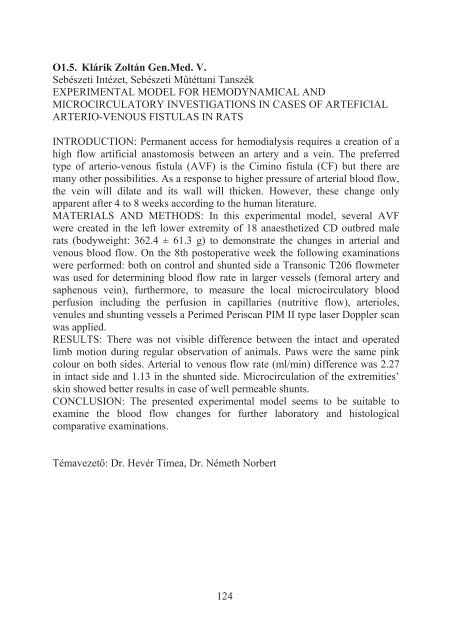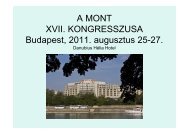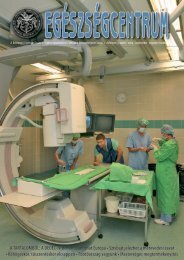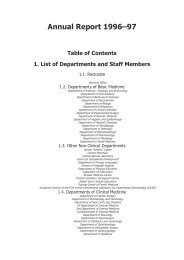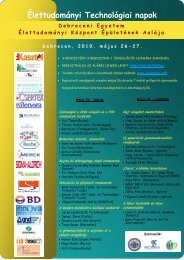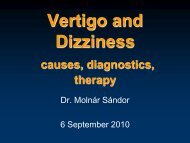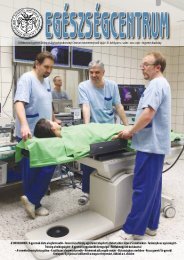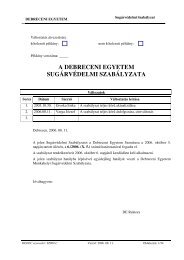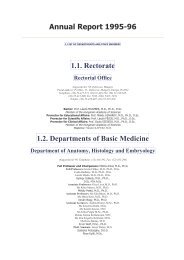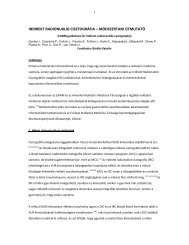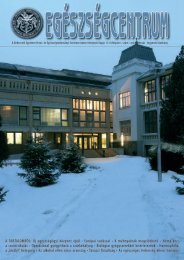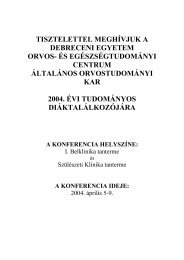- Page 1 and 2:
TISZTELETTEL MEGHÍVJUK ADEBRECENI
- Page 3:
A KONFERENCIA HAGYOMÁNYOSSZPONZORA
- Page 7 and 8:
SZEKCIÓ ELNÖKÖK2009. FEBRUÁR 18
- Page 9 and 10:
BÍRÁLÓ BIZOTTSÁGOK2009. FEBRUÁ
- Page 11 and 12:
TÁJÉKOZTATÓ• Az eladások maxi
- Page 13 and 14:
RÉSZLETES ROGRAM13
- Page 15 and 16:
P2 2009. FEBRUÁR 18. (SZERDA) 13:0
- Page 17 and 18:
P3.8. Kovács Anna Ildikó ÁOK VI.
- Page 19 and 20:
ÉLETTANE1 2009. FEBRUÁR 8. (SZERD
- Page 21 and 22:
E2 2009. FEBRUÁR 18. (SZERDA) 13:0
- Page 23 and 24:
G2 2009. FEBRUÁR 18. (SZERDA) 17:3
- Page 25 and 26:
K2 2009. FEBRUÁR 19. (CSÜT.) 10:3
- Page 27 and 28:
K4 2009. FEBRUÁR 19. (CSÜT.) 15:3
- Page 29 and 30:
K5.8. Kárai Bettina ÁOK VI.I. Bel
- Page 31 and 32:
MB1.8. Joós Gergely ÁOK IV.Bioké
- Page 33 and 34:
MB2.7. Nagy Zsuzsanna Mol.Biol. V.
- Page 35 and 36:
B1.7. Lajtos Tamás Mol.Biol. V.Bio
- Page 37 and 38:
B2.7. Erds Ádám Mol.Biol. V.Klini
- Page 39 and 40:
O2 2009. FEBRUÁR 20. (PÉNTEK) 10:
- Page 41 and 42:
MORFOLÓGIAM1 2009. FEBRUÁR 20. (P
- Page 43:
M3 2009. FEBRUÁR 20. (PÉNTEK) 13:
- Page 46 and 47:
E1.7. Ambrus Lídia Mol.Biol. V., L
- Page 48 and 49:
K4.5. Bajkó Nándor ÁOK VI.Gyerme
- Page 50 and 51:
K3.4. Balla Heidi ÁOK V.Szülésze
- Page 52 and 53:
G1.5. Bársony Alexandra Lilla Mol.
- Page 54 and 55:
B1.6. Berényi Erika NEK I.Szemklin
- Page 56 and 57:
O3.5. Birkás Orsolya ÁOK V.Aneszt
- Page 58 and 59:
G2.2. Boda Eszter GyTK V.Gyógyszer
- Page 60 and 61:
P3.6. Borbély Ágnes NEK V.Kórhá
- Page 62 and 63:
B2.4. Bozóki Beáta Mol.Biol. IV.B
- Page 64 and 65:
O1.4. Büdi Tímea ÁOK VI.Anesztez
- Page 66 and 67:
E2.3. Csató Viktória Mol.Biol. IV
- Page 68 and 69:
P4.7. Cserép Edit ÁOK IV.Szülés
- Page 70 and 71:
K1.1. Csontos Krisztina ÁOK VI.Inf
- Page 72 and 73:
G1.3. Dinshaw, Leon Gen.Med. III.,
- Page 74 and 75: E1.2. Erdei Erika Mol.Biol. V., Sza
- Page 76 and 77: M1.2. Erddi Balázs ÁOK VI., Guly
- Page 78 and 79: P2.8. Farkas Gyula ÁOK VI.II. Belk
- Page 80 and 81: G1.1. Fényi Anett ÁOK V.Farmakol
- Page 82 and 83: G1.4. Fürjes Gergely ÁOK VI.Farma
- Page 84 and 85: B2.9. Galyas Roland Mol.Biol. V.Bio
- Page 86 and 87: B1.2. Gergely Gábor Mol.Biol. V.Bi
- Page 88 and 89: P2.5. Gulyás Katalin ÁOK VI., Erd
- Page 90 and 91: E2.8. Gyrffy András ÁOK V.Orvosi
- Page 92 and 93: P4.1. Hajdú Krisztina NEK IV.Megel
- Page 94 and 95: G1.2. Hegedüs László ÁOK V.Farm
- Page 96 and 97: P3.3. Hernádi Balázs ÁOK VI.Szü
- Page 98 and 99: M3.1. Hollós Enik FOK IV., Jenei
- Page 100 and 101: P4.3. Horváth Melinda ÁOK V.III.
- Page 102 and 103: M2.6. Jakab András ÁOK VI.Orvosi
- Page 104 and 105: E1.8. Jenei Ágnes FOK IV., Hollós
- Page 106 and 107: K4.3. Jóna Ádám ÁOK V.III. Belk
- Page 108 and 109: MB1.8. Joós Gergely ÁOK IV.Bioké
- Page 110 and 111: K4.4. Kacsala Ákos ÁOK IV.I. Belk
- Page 112 and 113: P4.2. Kádár Zsuzsanna ÁOK VI.III
- Page 114 and 115: K3.5. Káli Gábor ÁOK V.Reumatol
- Page 116 and 117: M2.3. Katona Bernadett FOK V.Fogorv
- Page 118 and 119: M3.4. Kerékgyártó Csilla Regina
- Page 120 and 121: MB1.6. Keret, Ophir Gen.Med. IV.Bio
- Page 122 and 123: K2.6. Kiss Lilla ÁOK V.Gyermekgyó
- Page 126 and 127: P2.1. Koncz Tamás László ÁOK VI
- Page 128 and 129: M3.2. Koselák Mihály TTK IV.Nukle
- Page 130 and 131: P3.8. Kovács Anna Ildikó ÁOK VI.
- Page 132 and 133: M2.1. Kracskó Bertalan ÁOK V.Nukl
- Page 134 and 135: P1.7. Kun Edina ÁOK VI.Onkológiai
- Page 136 and 137: B1.7. Lajtos Tamás Mol.Biol. V.Bio
- Page 138 and 139: K2.2. Lantos Lajos ÁOK VI.Gyermekg
- Page 140 and 141: MB1.7. Lázár Nóra Gabriella ÁOK
- Page 142 and 143: M3.5. Lévay István TTK IV.Nukleá
- Page 144 and 145: M1.3. Major Gyöngyi Petra ÁOK V.K
- Page 146 and 147: E2.7. Megyesi Zita ÁOK V.Kardioló
- Page 148 and 149: P1.5. Meskó Bertalan ÁOK VI.Magat
- Page 150 and 151: O2.5. Mohácsi Annamária ÁOK V.An
- Page 152 and 153: P3.2. Molnár László ÁOK VI.Gyer
- Page 154 and 155: E2.6. Nagy Attila ÁOK IV.Klinikai
- Page 156 and 157: B2.1. Nagy Edit ÁOK V.Biokémiai
- Page 158 and 159: MB1.4. Nagy Gergely TTK V.Biokémia
- Page 160 and 161: O3.1. Nagy Sándor ÁOK V.Kenézy K
- Page 162 and 163: K5.3. Nagy-Baló Edina ÁOK V.Kardi
- Page 164 and 165: K5.1. Nyitrai Annamária ÁOK VI.In
- Page 166 and 167: M3.7. Oravecz Rita ÁOK III., Bére
- Page 168 and 169: O3.2. Orosz Gerg Balázs ÁOK V.Sz
- Page 170 and 171: E2.5. Orosz Petronella ÁOK V.Kardi
- Page 172 and 173: MB1.2. Pallai Anna Mol.Biol. V., Du
- Page 174 and 175:
M2.2. Papp Zsuzsanna Mol.Biol. IV.
- Page 176 and 177:
G2.1. Pósafalvi Anna GyTK V.Biofar
- Page 178 and 179:
O2.7. Posgay Titanilla ÁOK V.Urol
- Page 180 and 181:
K2.1. Rácz Lilla ÁOK V.II. Belkli
- Page 182 and 183:
O2.4. Rencsi Márta ÁOK VI.Idegseb
- Page 184 and 185:
K1.3. Sári Csilla Ildikó ÁOK V.,
- Page 186 and 187:
O3.4. Sárvári Károly Péter ÁOK
- Page 188 and 189:
K4.1. Simkó Éva ÁOK VI.Gyermekgy
- Page 190 and 191:
K1.7. Sipkó Ágnes ÁOK V.Gyermekg
- Page 192 and 193:
B1.4. Somlai Gerg István Mol.Biol.
- Page 194 and 195:
M2.7. Spisák Tamás TTK IV.Nukleá
- Page 196 and 197:
M1.1. Süt Renáta ÁOK IV.Anatómi
- Page 198 and 199:
K5.2. Szabó Katalin Judit ÁOK VI.
- Page 200 and 201:
O3.6. Szalai Eszter ÁOK VI., Vánt
- Page 202 and 203:
K5.7. Szamosújvári Judit ÁOK V.G
- Page 204 and 205:
K5.4. Szentimrei Réka ÁOK IV.I. B
- Page 206 and 207:
K4.2. Tácsik Anna ÁOK IV.Szülés
- Page 208 and 209:
P2.7. Tonté Dóra NEK V., Vincze J
- Page 210 and 211:
MB2.6. Tóth Ferenc Mol.Biol. V.Bio
- Page 212 and 213:
P3.5. Udvardi Tamás NEK IV.Magatar
- Page 214 and 215:
P3.1. Várvölgyi Tünde ÁOK VI.Br
- Page 216 and 217:
P2.6. Vincze Ferenc NEK III.Megelz
- Page 218 and 219:
K3.3. Wirtz Eszter ÁOK V.Kardioló
- Page 220:
K1.5. Zsíros Noémi ÁOK V.Kardiol


